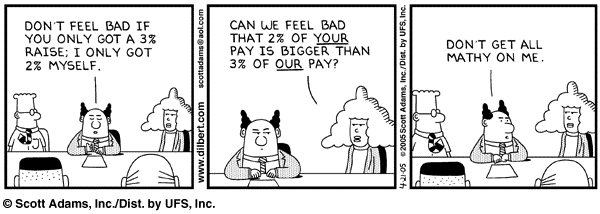Last week I wrote about how percentages are often misused to extrapolate reality instead of simplifying reality for the sake of communicating and comparing. I want to address another misuse of percent- the use of a percent as an objective or a goal.
I remember an odd discussion I had with a former manager. We were having that annual conversation about salary and she was saying that it was better for me to make 98% of my “target salary” than it was to make 102%. The reason was that the next year I could have a larger percent increase in pay since the maximum that the company allowed was 120%. So, 98% would give me more room to grow. When I insisted that I really would rather take 102% that current year instead of the higher percent increase in the next year she got all blurry eyed. As in the attached cartoon, I had gotten all “mathy” on her.
The reality is that my salary is really a hard number and not a percentage. When I take that check to the bank, there as a number and a currency symbol, not a pair of digits and percentage sign. Likewise, the important numbers on the corporate balance sheet is that bottom line… once again usually in dollars and not in a percentage. This distinction can be very important when we obsess with market share instead of revenue.
As an aside, I am not disparaging the importance of market share. Having a dominant share of a market does wonders for brand and company image- especially in a saturated market. However, even concepts like brand value are only important in that it positively affects revenue. Whether you’re a for-profit or a non-profit NGO that bottom line still matters. A non-profit or a business of the heart still requires sustainability.
So when I look at my own market strategy I engage heavily in coopetition. In other words I work alongside other market research firms on various projects. This may be hard to grasp since my competitor may benefit even more than I do, but it is revenue that matters and not share. In other words, I would trade a 10% share of a $10 million market for a 5% share of a $50 million market. By working with my competition I can increase the size and value of the market so that even though my 5% share is “half” of my former share, the resulting revenue of $2.5 million is an additional $1.5 million revenue. I could have put the same effort to compete and take more share but even doubling share to 20% of the same $10million market reaps less revenue than growing the market along with my competitor.
So keep your eye on the numerator. Remember that a percentage is really a fraction multiplied by 100%. It’s that top number of the fraction that relates the real number being measure: It’s the number of people in the population you may be surveying or- more importantly- the amount you are actually being paid out of an imaginary “target salary”.


